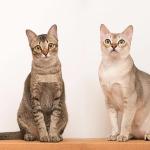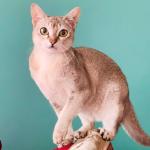Singapura

The Singapore cat is a very small breed, but it strong and muscular. The first thing that catches your attention about Singapore breed are its large outlined eyes and characteristic sepia-colored fur. It is an Asian cat breed and is known for not using much vocalization. In general, they are a calm, intelligent and affectionate cat than other related breeds.
They had probably lived on the streets of Singapore for many years, specifically in sewers. They were previously ignored by its inhabitants. It was in the last decades of the twentieth century when American breeders became interested in these cats to the point of starting a breeding program. This led to the beautiful breed that we know today, accepted by most cat breed associations. Read on to learn more about the Singaporean cat, its characteristics, personality, care and health problems.
- Asia
- Singapore
- Category III
- 7-11
- 11-13
- 13-17
- 17-22
- 22-30
- 8-10
- 10-15
- 15-18
- 18-20
Origin of the Singapura cat
Perhaps unsurprisingly, the Singapura cat comes from Singapore. In its original Malay terminology, Singapore means ‘city of lions’. The breed was first discovered by American breeders in 1970 by two men named Hal and Tommy Meadow. They bred Siamese and Burmese cats. They imported some of the Singapura breed to the US and Hal came back for more the following year. In 1975, they started a breeding program and enlisted the help of some British geneticists.
In 1987, breeder Gerry Mayes traveled to Singapore to search for other specimens of Singapura cats. He brought them back to the States to register the with the TICA (The International Cat Association). The Cat Fancier's Association registered Singapura cats in 1982, first being admitted to championships in 1988. They arrived in Europe at the end of the 1980s, specifically in the UK, but did not receive as much success there. It wasn't until 2014 they were recognized by the FIFE (International Feline Federation).
It is said that these cats lived in narrow pipes in Singapore to protect themselves from the summer heat and to get away from local inhabitants who held them in low-esteem. For this reason, they received the name of ‘drain cats’. Due to the latter reason, their age is not known with certainty, but it is believed the breed is at least 300 years old and appeared most likely as a result of crosses between Abyssinian and Burmese cats. It is known from DNA tests that it is genetically very similar to the Burmese cat.
Physical characteristics of the Singapura cat
What stands out most about Singapura cats is their small size, as they are considered the smallest breed in the world. In this breed, males and females do not weigh more than 3 or 4 kg, reaching adult size between 15 and 24 months of age. Despite their small size, they have good musculature and a slim, but athletic body. This provides them with acute jumping skills.
Their head is round, with a short snout, a salmon-colored nose, and fairly large, oval green, copper or gold eyes outlined by a black line. The ears are large and pointed with a broad base. The tail is medium, fine and thin, the limbs are well muscled and the feet are round and small.
Singapura cat breed coat colors
The officially recognized coat color is sepia agouti (a type of tabby pattern), while it appears to be a single color, the individual strands of hair alternate between light and dark. This is known as partial albinism and causes acromelanism or dark coloration in the regions of the body with lower temperatures. These include the face, ears, legs and tail. When kittens are born they are much lighter and it is not until 3 years of age that their silky coat is fully developed and displays its final color.
Character of the Singapura cat
The Singapura cat breed is characterized by being an intelligent, curious, calm and very affectionate. They like to be with their caregiver, so they will seek warmth by climbing on them or staying by their side to accompany them around the house. They are very fond of heights and jumping, so they will seek high places with good views. They are not very active, but not completely sedentary, as they love to play and seek. Unlike other cats of oriental origin, Singapura cats have a much softer and less frequent meow.
In the face of new family members or strangers at home they may be somewhat reserved. With sensitivity and patience they will open up and be affectionate with the new individuals after time. They are an ideal breed for companionship and generally get along well with children and other cats.
They are affectionate but at the same time more independent than other breeds and will need time alone. It is a suitable breed, therefore, for people who work outside the home, but when they return they must be encouraged and played to show the affection that they will undoubtedly provide.
Singapura cat care
A great advantage that this cat has for many caregivers is that they have short hair and hardly shed. This means they only usually require one or two brushing sessions per week.
The Singapura cat diet must be complete and of good quality to cover all their necessary nutritional needs. As with all cats, this means it will need a high protein content. Keep in mind that they are small cats and, therefore, they will need to eat less than a cat of a larger breed. As always, it will need to be adjusted to their age, physiological state and health.
Although they are not very dependent cats, they do require you to spend a little time with them every day. They love games and it is very important that they get enough exercise for the correct development of their muscles and so that they remain healthy and strong. To give you some ideas, you can read this other article on 10 games to entertain your cat.
Singapura cat health
Among the diseases that can specifically affect the Singapura cat breed are:
- Pyruvate kinase deficiency: hereditary disease in which the PKLR gene intervenes, which can affect Singapura and other breeds. These include the Abyssinian, Bengal, Maine Coon, Norwegian Forest Cat, Siberian and others. Pyruvate kinase is an enzyme involved in the metabolism of sugars in red blood cells. If this enzyme is deficient, the red blood cells die, causing anemia with associated symptoms: tachycardia, tachypnea, pale mucous membranes, and weakness. Depending on the evolution and severity of the disease, the life expectancy of these cats varies between 1 and 10 years.
- Progressive retinal atrophy: a recessive inherited disease involving a CEP290 gene mutation and symptoms consist of a progressive loss of vision with degeneration of photoreceptors and blindness by 3-5 years of age. Singapura cats are more predisposed, as well as Somali, Occat, Abyssinian, Munchkin, Siamese and Tonkinese breeds.
In regards to other health problems, they can be affected by the same infectious, parasitic or organic diseases as other cats. Their life expectancy is up to 15 years. For all these reasons, we recommend a routine veterinary visit for vaccination and deworming and check-ups, especially monitoring the kidneys. Always take them to a veterinarian if there are any symptoms of common diseases in cats.
Where to adopt a Singapura cat
If with what you have read you have thought that this is your breed, the first thing is to go to shelters and cat associations and ask about the availability of a Singapura cat. Although it is rare, especially in places other than Singapura or the United States, you may be lucky or hear of a reputable place which may have some specimens available.
Another option is to check if there is an association in your area that specializes in the rescue and subsequent adoption of this breed of cat. You also have the possibility of adopting a cat online. Through the Internet, you can consult the registered cat breeders and check their reputation. This way we can avoid inhumane animal breeding practices.
Singapura photos














